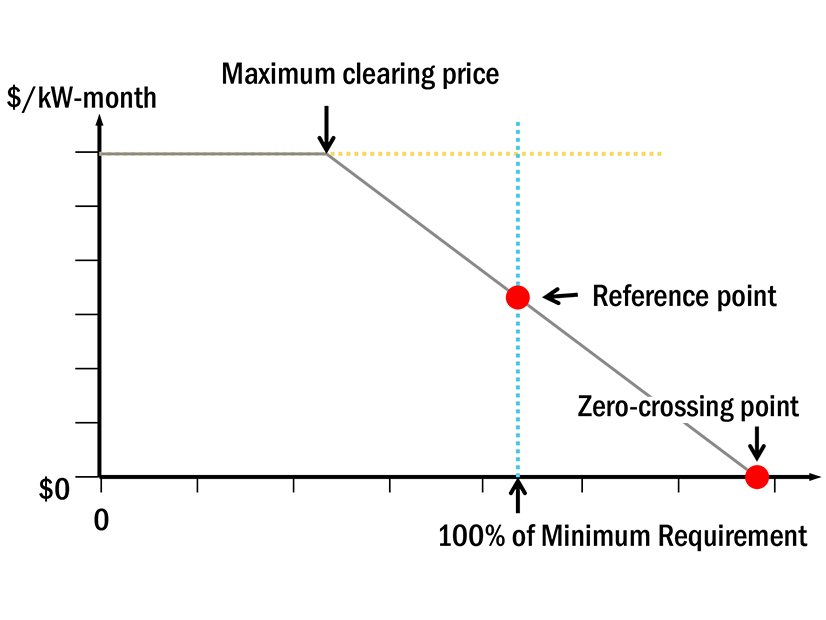FERC on Friday approved NYISO’s proposed 17-year amortization period when calculating the annual costs for hypothetical fossil fuel peaker plants, a key parameter in its capacity market demand curve (ER21-502).
The order reversed its two previous rejections of the ISO’s proposal, including one on remand from the D.C. Circuit Court of Appeals. The amortization period is now the assumed length of time over which a hypothetical gas-fired power plant is expected to be operational and is used to calculate the net annual cost of new entry (CONE), itself used to calculate the demand curve.
NYISO proposed to move from a 20-year amortization period to 17 years because New York’s enactment of the Climate Leadership and Community Protection Act (CLCPA), which set strict net-zero emission and energy requirements by 2040, will, according to the ISO, force fossil plants to retire sooner.
The proposal was part of a larger set of changes collectively called the demand curve reset (DCR), which altered the parameters and assumptions for capability years 2021/22 through 2024/25. The DCR was approved by FERC on April 9, 2021, though it rejected the 17-year amortization period. (See FERC Approves NY Demand Curve Reset, Rejects 17-Year Amortization.)
The commission had said the proposed period was “speculative and may result in unnecessarily high net CONE estimates” and “fails to consider that the CLCPA does not require that power generators retire in order to satisfy the 2040 zero-emission requirement.”
The Independent Power Producers of New York (IPPNY) appealed FERC’s ruling to the D.C. Circuit, which vacated and remanded the order on Aug. 9, 2022, saying the commission had failed to properly explain its reasoning. (See “DC Circuit Ruling,” No Consensus on PJM Capacity Parameters.)
In response, FERC in December affirmed its earlier rejection with more explanation. It continued to emphasize that the CLCPA did not require plant retirements, as new fuels or retrofits could enable zero-emission dispatchable resources to meet the 2040 zero-emission target.
IPPNY filed a rehearing request, saying the commission “largely recast” the same arguments found insufficient by the D.C. Circuit, ignored the “plain language” of the CLCPA and failed to provide evidence showing NYISO’s proposal is unjust and unreasonable.
The court had said that because NYISO had filed under Federal Power Act Section 205, it was only required to show that its proposal was just and reasonable in and of itself — not whether it is more or less reasonable than alternative designs.
IPPNY also argued that FERC’s reliance on evidence from NYISO’s Market Monitoring Unit and the New York Public Service Commission, which both wanted to maintain the 20-year period, was inappropriate because neither could know “which resources or technologies will be feasible, economically viable or eventually permitted by the state to meet the goals of the CLCPA.”
“Upon further consideration, we set aside the prior determination and conclude that NYISO’s proposal reflects a reasonable interpretation of the CLCPA,” FERC said Friday. “NYISO had to make certain assumptions, which NYISO made based on the currently effective laws and regulations. Given the information available, NYISO’s choices were reasonable. … NYISO’s decision to not consider the potential for new fuels and technologies enabled NYISO to avoid speculating about future technological development and costs.”
NYISO must now submit compliance filings within 21 days of Friday’s ruling that show how the ISO will adopt the new 17-year amortization period for the remainder of the 2021-2025 DCR.
Commissioner Mark Christie dissented against the majority’s decision, arguing that FERC’s reversal not only undermines the commission’s original decisions but disregards expert consensus from the PSC and MMU, whose support for the 20-year period was based on existing knowledge of New York’s energy markets.
Christie said evidence presented suggests that the 17-year proposal would result in “higher costs borne by consumers” and “unnecessarily high net CONE estimates for the proxy peaking unit.”
By the PSC’s own admission, “continuing a 20-year amortization period follows the plain reading of the [CLCPA], which explicitly provides for these implementation processes to be developed over many years and does not require all generation currently running on fossil fuels or the hypothetical proxy unit to retire by 2040,” Christie said.



